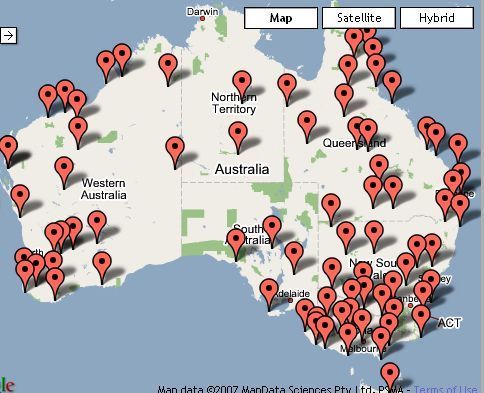There are many weather stations throughout Australia, and the ABM’s most recent report utilises around 100 of these from non urban areas. I have gathered data on these 100 stations, and eliminating one’s that do not have maximum or minimum temperature data from at least the 1970s, the map below shows the stations that are available for analysis:

What is notable from the map is that more weather stations are situation closer to where people live. This of course is understandable considering that in the past we were really only interested in the weather where we currently reside. There are large numbers of stations in Victoria, around Perth, throughout New South Wales and along the coastline. However there are also some gaps in stations in certain areas. Tasmania only has one non urban weather station with adequate temperature data. There is no stations in the northern half of south Australia. The northern territory has only 2 adequate stations, and almost the entire eastern half of western Australia is missing.
So how does one analyse such information given? Well the ABM say that they use a weighted average, in that stations are weighted due to the area of Australia. Hence in Victoria, each individual station is not counted for as much as say, in the northern territory, however combined they might well be equal. This is a complex analysis, but one that has to be looked at very closely.
We will do this on this website, step by step. In the next coming days, we will look at every section of Australia, looking at maximum and minimum temperatures and temperatures during certain times of the day. Information that has unfortunately not been analysed before, not even in the scientific literature.
One side difference however, is that we will not be analysing temperatures with reference to the 1961 to 1990 average. Instead will be analysing temperatures with reference to the average of the life span of the weather station – something which is more accurate, provides more meaningful information however is harder to compute. Luckily, I am also a computer programmer as well as a statistician.
So look back here in the next coming weeks, starting tomorrow we shall look at Giles Meteorological Office, Australia’s most isolated weather station situated on the central eastern border of Western Australia.
2 comments:
I think a lot of country weather stations closed in the early 1990's.
It might of coincided with the closure of post offices and suchlike that used to record the weather.
I'm pretty sure the BoM claim there are still a lot of country stations but I don't trust them.
Good luck with the analyses.
Thanks for the site. Highly informative. Your hard work is much appreciated.
I look forward to this new analysis. I'll keep my indoctrinated friends infoirmed but alas for all their faith in 'science' they have thus far shown themselves immune to actual scientific argument.
But eventually, many the small voices must be heard, musn't they?
Post a Comment